Abstract
Neuropeptides containing the C-terminal sequence Arg-Phe-NH2 (RFamide) occur throughout the Animal Kingdom and are abundant in evolutionarily 'old' nervous systems such as those of cnidarians. From the hydromedusa Polyorchis penicillatus we have previously isolated two neuropeptides, Pol-RFamide I (<Glu-Leu-Leu-Gly-Gly-Arg-Phe-NH2) and Pol-RFamide II (<Glu-Trp-Leu-Lys-Gly-Arg-Phe-NH2). Here we describe the cloning of a common precursor protein for these peptides from P. penicillatus. The precursor protein contains one copy of Pol-RFamide I, 11 copies of Pol-RFamide II and one putative neuropeptide sequence. The Pol-RFamide I sequence is flanked by pairs of basic residues (Arg-Lys). At the C-termini of all Pol-RFamide II sequences, single basic residues (Arg) occur. Paired and single basic residues are established sites for post-translational precursor cleavage. At the N-termini of the Pol-RFamide II sequences, however, basic residues are lacking and, instead, either single Asp (in eight cases) or single Asn residues (in three cases) occur. This means that processing must take place at Asp and/or Asn residues. This is firm evidence for the presence of one or more unconventional processing enzymes. The first type of processing enzyme could be an endoproteinase or aminopeptidase hydrolysing at the C-terminal side of Asp residues. Proteolytic cleavage at acidic amino acid residues has previously been inferred from other cnidarian neuropeptide precursors. The second type of processing enzyme could be an endoproteinase or aminopeptidase hydrolysing at the C-terminal side of Asn residues.
Full text
PDF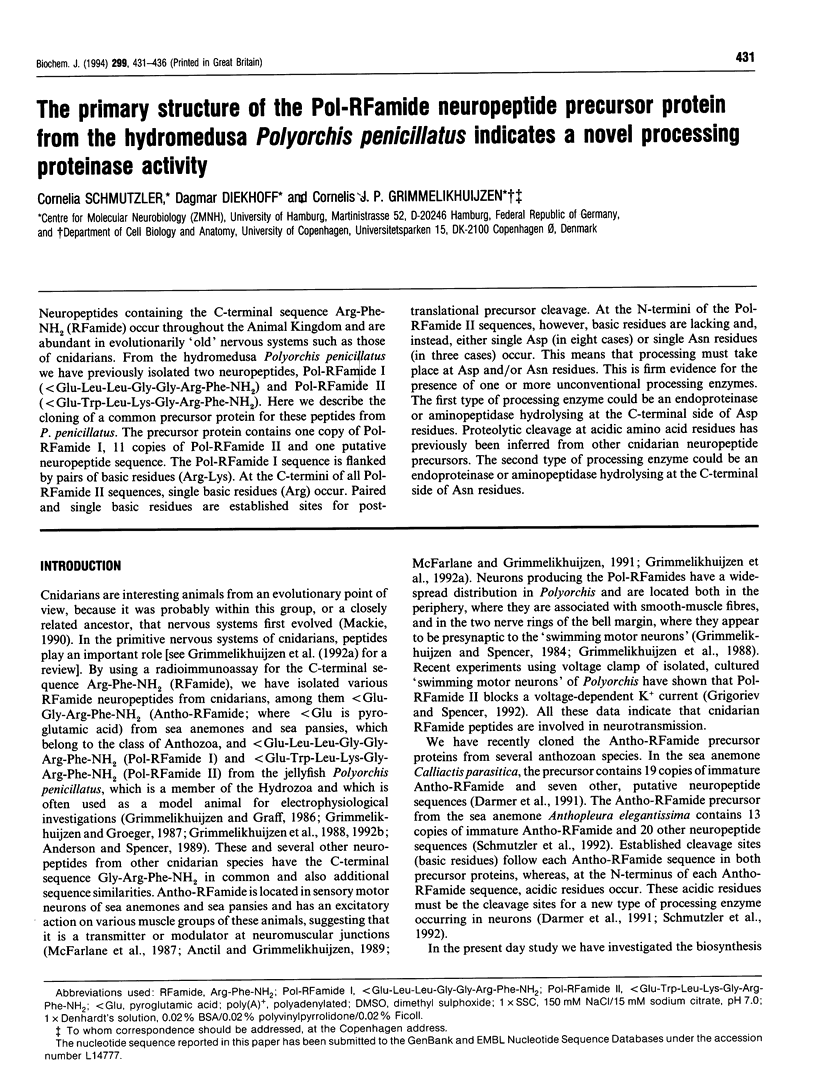

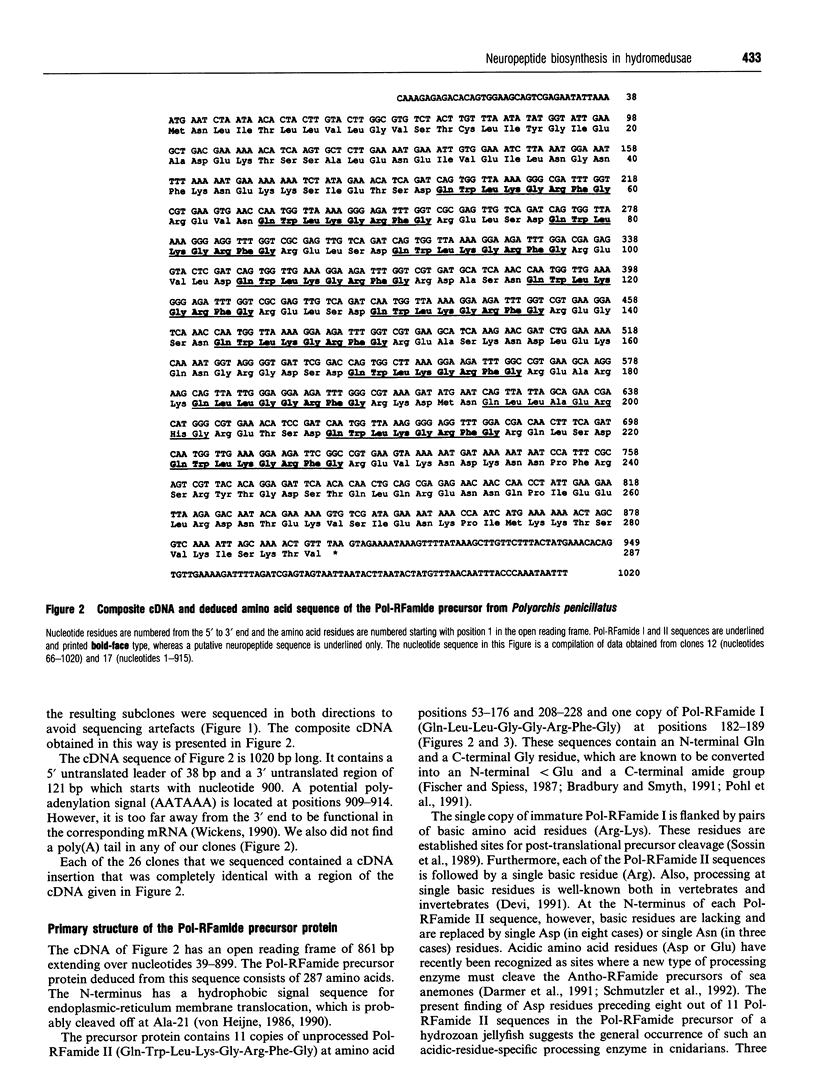
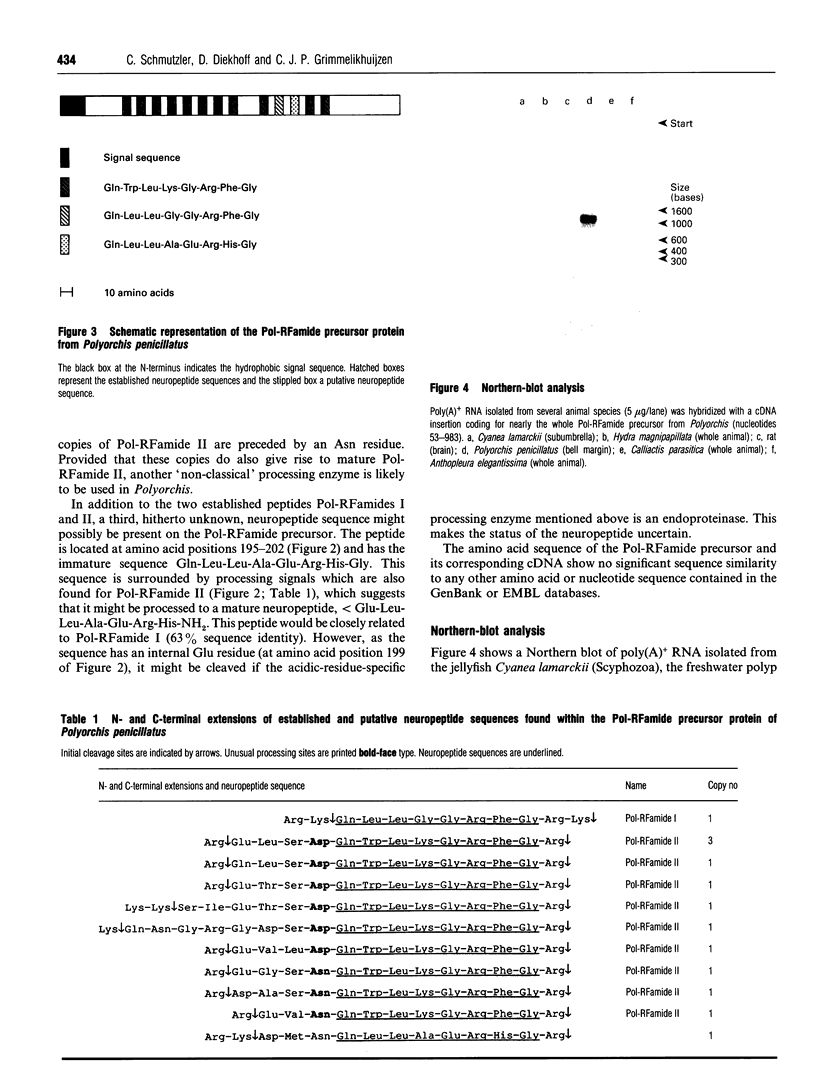
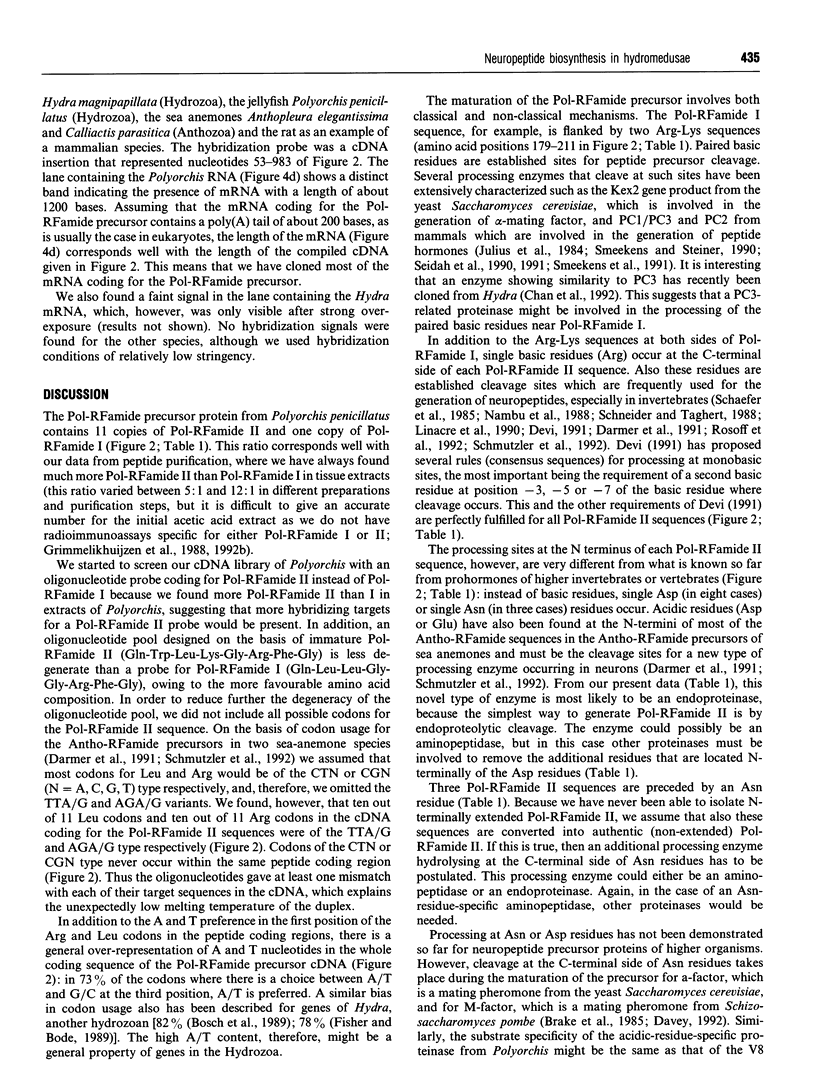
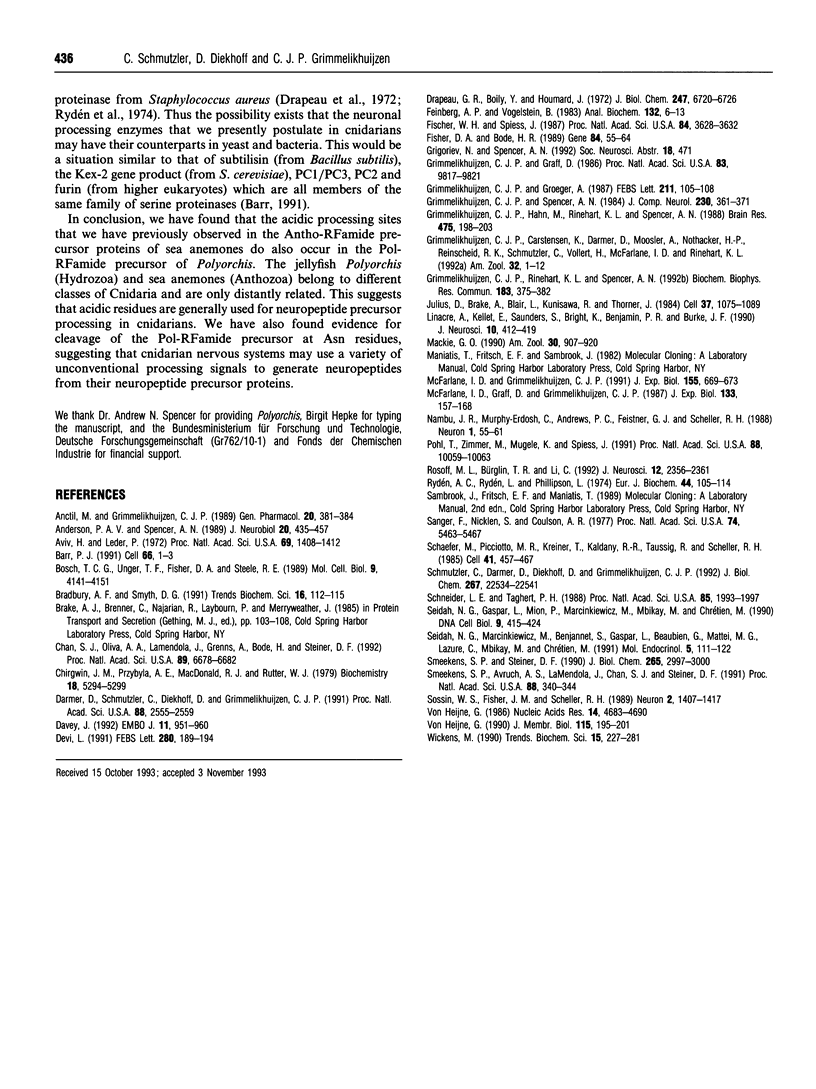
Images in this article
Selected References
These references are in PubMed. This may not be the complete list of references from this article.
- Anctil M., Grimmelikhuijzen C. J. Excitatory action of the native neuropeptide antho-rfamide on muscles in the pennatulid Renilla köllikeri. Gen Pharmacol. 1989;20(3):381–384. doi: 10.1016/0306-3623(89)90277-2. [DOI] [PubMed] [Google Scholar]
- Anderson P. A., Spencer A. N. The importance of cnidarian synapses for neurobiology. J Neurobiol. 1989 Jul;20(5):435–457. doi: 10.1002/neu.480200513. [DOI] [PubMed] [Google Scholar]
- Aviv H., Leder P. Purification of biologically active globin messenger RNA by chromatography on oligothymidylic acid-cellulose. Proc Natl Acad Sci U S A. 1972 Jun;69(6):1408–1412. doi: 10.1073/pnas.69.6.1408. [DOI] [PMC free article] [PubMed] [Google Scholar]
- Barr P. J. Mammalian subtilisins: the long-sought dibasic processing endoproteases. Cell. 1991 Jul 12;66(1):1–3. doi: 10.1016/0092-8674(91)90129-m. [DOI] [PubMed] [Google Scholar]
- Bosch T. C., Unger T. F., Fisher D. A., Steele R. E. Structure and expression of STK, a src-related gene in the simple metazoan Hydra attenuata. Mol Cell Biol. 1989 Oct;9(10):4141–4151. doi: 10.1128/mcb.9.10.4141. [DOI] [PMC free article] [PubMed] [Google Scholar]
- Bradbury A. F., Smyth D. G. Peptide amidation. Trends Biochem Sci. 1991 Mar;16(3):112–115. doi: 10.1016/0968-0004(91)90044-v. [DOI] [PubMed] [Google Scholar]
- Chan S. J., Oliva A. A., Jr, LaMendola J., Grens A., Bode H., Steiner D. F. Conservation of the prohormone convertase gene family in metazoa: analysis of cDNAs encoding a PC3-like protein from hydra. Proc Natl Acad Sci U S A. 1992 Aug 1;89(15):6678–6682. doi: 10.1073/pnas.89.15.6678. [DOI] [PMC free article] [PubMed] [Google Scholar]
- Chirgwin J. M., Przybyla A. E., MacDonald R. J., Rutter W. J. Isolation of biologically active ribonucleic acid from sources enriched in ribonuclease. Biochemistry. 1979 Nov 27;18(24):5294–5299. doi: 10.1021/bi00591a005. [DOI] [PubMed] [Google Scholar]
- Darmer D., Schmutzler C., Diekhoff D., Grimmelikhuijzen C. J. Primary structure of the precursor for the sea anemone neuropeptide Antho-RFamide (less than Glu-Gly-Arg-Phe-NH2). Proc Natl Acad Sci U S A. 1991 Mar 15;88(6):2555–2559. doi: 10.1073/pnas.88.6.2555. [DOI] [PMC free article] [PubMed] [Google Scholar]
- Davey J. Mating pheromones of the fission yeast Schizosaccharomyces pombe: purification and structural characterization of M-factor and isolation and analysis of two genes encoding the pheromone. EMBO J. 1992 Mar;11(3):951–960. doi: 10.1002/j.1460-2075.1992.tb05134.x. [DOI] [PMC free article] [PubMed] [Google Scholar]
- Devi L. Consensus sequence for processing of peptide precursors at monobasic sites. FEBS Lett. 1991 Mar 25;280(2):189–194. doi: 10.1016/0014-5793(91)80290-j. [DOI] [PubMed] [Google Scholar]
- Drapeau G. R., Boily Y., Houmard J. Purification and properties of an extracellular protease of Staphylococcus aureus. J Biol Chem. 1972 Oct 25;247(20):6720–6726. [PubMed] [Google Scholar]
- Feinberg A. P., Vogelstein B. A technique for radiolabeling DNA restriction endonuclease fragments to high specific activity. Anal Biochem. 1983 Jul 1;132(1):6–13. doi: 10.1016/0003-2697(83)90418-9. [DOI] [PubMed] [Google Scholar]
- Fischer W. H., Spiess J. Identification of a mammalian glutaminyl cyclase converting glutaminyl into pyroglutamyl peptides. Proc Natl Acad Sci U S A. 1987 Jun;84(11):3628–3632. doi: 10.1073/pnas.84.11.3628. [DOI] [PMC free article] [PubMed] [Google Scholar]
- Fisher D. A., Bode H. R. Nucleotide sequence of an actin-encoding gene from Hydra attenuata: structural characteristics and evolutionary implications. Gene. 1989 Dec 7;84(1):55–64. doi: 10.1016/0378-1119(89)90139-x. [DOI] [PubMed] [Google Scholar]
- Grimmelikhuijzen C. J., Graff D. Isolation of pyroGlu-Gly-Arg-Phe-NH2 (Antho-RFamide), a neuropeptide from sea anemones. Proc Natl Acad Sci U S A. 1986 Dec;83(24):9817–9821. doi: 10.1073/pnas.83.24.9817. [DOI] [PMC free article] [PubMed] [Google Scholar]
- Grimmelikhuijzen C. J., Hahn M., Rinehart K. L., Spencer A. N. Isolation of pyroGlu-Leu-Leu-Gly-Gly-Arg-Phe-NH2 (Pol-RFamide), a novel neuropeptide from hydromedusae. Brain Res. 1988 Dec 13;475(1):198–203. doi: 10.1016/0006-8993(88)90219-3. [DOI] [PubMed] [Google Scholar]
- Grimmelikhuijzen C. J., Rinehart K. L., Spencer A. N. Isolation of the neuropeptide less than Glu-Trp-Leu-Lys-Gly-Arg-Phe-NH2 (Pol-RFamide II) from the hydromedusa Polyorchis penicillatus. Biochem Biophys Res Commun. 1992 Mar 16;183(2):375–382. doi: 10.1016/0006-291x(92)90491-3. [DOI] [PubMed] [Google Scholar]
- Grimmelikhuijzen C. J., Spencer A. N. FMRFamide immunoreactivity in the nervous system of the medusa Polyorchis penicillatus. J Comp Neurol. 1984 Dec 10;230(3):361–371. doi: 10.1002/cne.902300305. [DOI] [PubMed] [Google Scholar]
- Julius D., Brake A., Blair L., Kunisawa R., Thorner J. Isolation of the putative structural gene for the lysine-arginine-cleaving endopeptidase required for processing of yeast prepro-alpha-factor. Cell. 1984 Jul;37(3):1075–1089. doi: 10.1016/0092-8674(84)90442-2. [DOI] [PubMed] [Google Scholar]
- Linacre A., Kellett E., Saunders S., Bright K., Benjamin P. R., Burke J. F. Cardioactive neuropeptide Phe-Met-Arg-Phe-NH2 (FMRFamide) and novel related peptides are encoded in multiple copies by a single gene in the snail Lymnaea stagnalis. J Neurosci. 1990 Feb;10(2):412–419. doi: 10.1523/JNEUROSCI.10-02-00412.1990. [DOI] [PMC free article] [PubMed] [Google Scholar]
- Nambu J. R., Murphy-Erdosh C., Andrews P. C., Feistner G. J., Scheller R. H. Isolation and characterization of a Drosophila neuropeptide gene. Neuron. 1988 Mar;1(1):55–61. doi: 10.1016/0896-6273(88)90209-7. [DOI] [PubMed] [Google Scholar]
- Pohl T., Zimmer M., Mugele K., Spiess J. Primary structure and functional expression of a glutaminyl cyclase. Proc Natl Acad Sci U S A. 1991 Nov 15;88(22):10059–10063. doi: 10.1073/pnas.88.22.10059. [DOI] [PMC free article] [PubMed] [Google Scholar]
- Rosoff M. L., Bürglin T. R., Li C. Alternatively spliced transcripts of the flp-1 gene encode distinct FMRFamide-like peptides in Caenorhabditis elegans. J Neurosci. 1992 Jun;12(6):2356–2361. doi: 10.1523/JNEUROSCI.12-06-02356.1992. [DOI] [PMC free article] [PubMed] [Google Scholar]
- Rydén A. C., Rydén L., Philipson L. Isolation and properties of a staphylococcal protease, preferentially cleaving glutamoyl-peptide bonds. Eur J Biochem. 1974 May 2;44(1):105–114. doi: 10.1111/j.1432-1033.1974.tb03462.x. [DOI] [PubMed] [Google Scholar]
- Sanger F., Nicklen S., Coulson A. R. DNA sequencing with chain-terminating inhibitors. Proc Natl Acad Sci U S A. 1977 Dec;74(12):5463–5467. doi: 10.1073/pnas.74.12.5463. [DOI] [PMC free article] [PubMed] [Google Scholar]
- Schaefer M., Picciotto M. R., Kreiner T., Kaldany R. R., Taussig R., Scheller R. H. Aplysia neurons express a gene encoding multiple FMRFamide neuropeptides. Cell. 1985 Jun;41(2):457–467. doi: 10.1016/s0092-8674(85)80019-2. [DOI] [PubMed] [Google Scholar]
- Schmutzler C., Darmer D., Diekhoff D., Grimmelikhuijzen C. J. Identification of a novel type of processing sites in the precursor for the sea anemone neuropeptide Antho-RFamide (<Glu-Gly-Arg-Phe-NH2) from Anthopleura elegantissima. J Biol Chem. 1992 Nov 5;267(31):22534–22541. [PubMed] [Google Scholar]
- Schneider L. E., Taghert P. H. Isolation and characterization of a Drosophila gene that encodes multiple neuropeptides related to Phe-Met-Arg-Phe-NH2 (FMRFamide). Proc Natl Acad Sci U S A. 1988 Mar;85(6):1993–1997. doi: 10.1073/pnas.85.6.1993. [DOI] [PMC free article] [PubMed] [Google Scholar]
- Seidah N. G., Gaspar L., Mion P., Marcinkiewicz M., Mbikay M., Chrétien M. cDNA sequence of two distinct pituitary proteins homologous to Kex2 and furin gene products: tissue-specific mRNAs encoding candidates for pro-hormone processing proteinases. DNA Cell Biol. 1990 Jul-Aug;9(6):415–424. doi: 10.1089/dna.1990.9.415. [DOI] [PubMed] [Google Scholar]
- Seidah N. G., Marcinkiewicz M., Benjannet S., Gaspar L., Beaubien G., Mattei M. G., Lazure C., Mbikay M., Chrétien M. Cloning and primary sequence of a mouse candidate prohormone convertase PC1 homologous to PC2, Furin, and Kex2: distinct chromosomal localization and messenger RNA distribution in brain and pituitary compared to PC2. Mol Endocrinol. 1991 Jan;5(1):111–122. doi: 10.1210/mend-5-1-111. [DOI] [PubMed] [Google Scholar]
- Smeekens S. P., Avruch A. S., LaMendola J., Chan S. J., Steiner D. F. Identification of a cDNA encoding a second putative prohormone convertase related to PC2 in AtT20 cells and islets of Langerhans. Proc Natl Acad Sci U S A. 1991 Jan 15;88(2):340–344. doi: 10.1073/pnas.88.2.340. [DOI] [PMC free article] [PubMed] [Google Scholar]
- Smeekens S. P., Steiner D. F. Identification of a human insulinoma cDNA encoding a novel mammalian protein structurally related to the yeast dibasic processing protease Kex2. J Biol Chem. 1990 Feb 25;265(6):2997–3000. [PubMed] [Google Scholar]
- Sossin W. S., Fisher J. M., Scheller R. H. Cellular and molecular biology of neuropeptide processing and packaging. Neuron. 1989 May;2(5):1407–1417. doi: 10.1016/0896-6273(89)90186-4. [DOI] [PubMed] [Google Scholar]
- Wickens M. How the messenger got its tail: addition of poly(A) in the nucleus. Trends Biochem Sci. 1990 Jul;15(7):277–281. doi: 10.1016/0968-0004(90)90054-f. [DOI] [PubMed] [Google Scholar]
- von Heijne G. A new method for predicting signal sequence cleavage sites. Nucleic Acids Res. 1986 Jun 11;14(11):4683–4690. doi: 10.1093/nar/14.11.4683. [DOI] [PMC free article] [PubMed] [Google Scholar]
- von Heijne G. The signal peptide. J Membr Biol. 1990 May;115(3):195–201. doi: 10.1007/BF01868635. [DOI] [PubMed] [Google Scholar]



